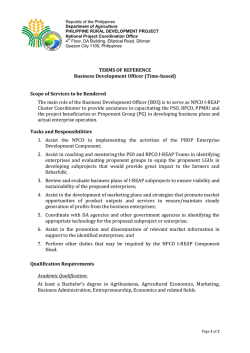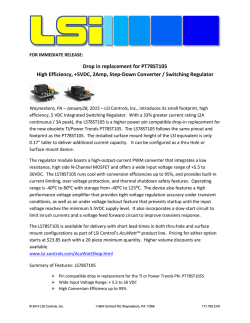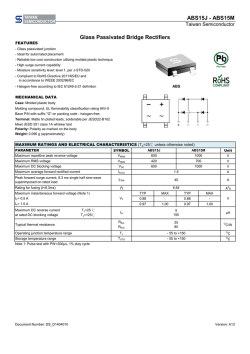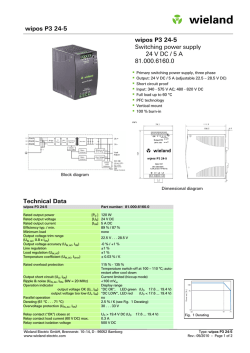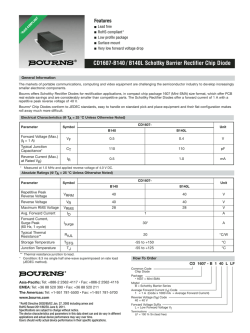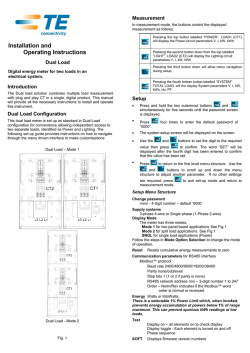
Single objective optimization using PSO with Interline Power Flow
International Electrical Engineering Journal (IEEJ) Vol. 5 (2014) No.12, pp. 1659-1664 ISSN 2078-2365 http://www.ieejournal.com/ Single objective optimization using PSO with Interline Power Flow Controller Praveen.J, B.Srinivasa Rao [email protected], [email protected] Abstract — Optimal Power Flow (OPF) problem was solving from the decades with different objectives as the economy was growing. In this paper cost of generation, transmission losses and L-index are taken as three different objectives for optimal operation of power system with and without FACTS device. One of the VSC based multi type FACTS device namely an Interline Power Flow Controller (IPFC) is placed into power system network. The optimization problem has been solved by using Particle Swarm Optimization (PSO) with power injection model of the FACTS device. The proposed methodology is tested on standard IEEE 30-bus test system and the results are compared for single objective optimization with and without FACTS device. Index Terms— IPFC, PSO, OPF. I. INTRODUCTION The Optimal Power Flow (OPF) problem was first formulated in 1960’s and Carpentier done major research in 1962 and then it found to be as not an easy problem since optimal power flow itself defined as the combination of economic dispatch i.e., minimization of cost function such as operating cost by considering realistic or practical equality and inequality constraints. In this paper single objective optimization has been done for OPF i.e., cost, loss, and L-index. When cost is taken as the objective cost should be minimized as minimum as possible without violation of the constraints and the same case with loss and L-index. The control variables such as Pg’s (generated real powers), Vg’s (voltages at generators), Tap’s (transformer tap settings) and Qc’s (reactive power injections) are considered for optimal operation of power system using Particle Swarm Optimization (PSO). PSO is superior in convergence characteristics and has shorter execution time when compared to other Evolutionary Programing (EP) and classical methods. Where as the classical methods[1] like Gradient method, Quadratic Programing (QP), Linear Programming(LP), Non-Linear Programming (NLP), and Interior point method have the drawback of dimensionality, slow convergence and thus clsassical methods turned unfeasible to implement. In [2] PSO was applied for optimal location of FACTS devices cosnsidering cost of installation and system loadability. Here FACTS devices were used to increase the loadability of the system by controlling the electrical parameters. Power electronic devices plays a major role in FACTS devices here IPFC uses two Voltage Source Converters (VSC) which will control the bi-directional power flow between two lines. Rest of the paper is organised into six sections. In section-II, problem formulation for optimal power flow is explained with objectives and constraints. The overview of particle swarm optimization is given in section-III. The section IV deals with the algorithm implimented for OPF using PSO. A brief description about power injection model of IPFC is given in section V. In section VI simulation results are analysed and finally conclusions are drawn in section VII. II. PROBLEM FORMULATION The main goal of the OPF problem is to optimize a selected objective function via optimal adjustment of the power system control variables, subject to several equality and inequality constraints [3]. The optimal power flow problem can be mathematically formulated as follows: Min F(x,u) (1) Subject to: g(x,u) = 0 (2) h min ≤ h(x,u) ≤ h max (3) Where: F - objective function to be minimized x - vector of dependent variables (state variables) u - vector representing all control variables g - equality constraints representing line flow equation h - inequality constraints representing operating limits of control variables. A. Objective functions 1) Cost objective Cost of generation is one of the major objective it is not only economical but also increases the transmission efficiency because losses will be decreased when cost of generation is decreased which is generally observed. Mathematical form for generation cost is stated as follows [4] 𝑁𝑔𝑒𝑛 2 𝐹1 (𝑋) = ∑𝑖=1 (𝑎𝑖 𝑃𝑔𝑖 + 𝑏𝑖 𝑃𝑔𝑖 + 𝑐𝑖 )$/ℎ (4) Where X=[Pg,Vg,Taps,Qc]1xn (5) Pg=[Pg1,Pg2,Pg3,…..Pg(Ngen-1)]1x(Ngen-1) (6) Vg=[Vg1,Vg2,Vg3,….VgNgen]1xNgen (7) Taps=[Tap1,Tap2,Tap3,….,TapNtran]1xNtran (8) Qc=[Qc1,Qc2,…Qc3,……QcNcap]1xNcap (9) N=(Ntran+Ncap+Ngen+(Ngen-1)) (10) 1659 Praveen. and Srinivasa Single objective optimization using PSO with Interline Power Flow Controller International Electrical Engineering Journal (IEEJ) Vol. 5 (2014) No.12, pp. 1659-1664 ISSN 2078-2365 http://www.ieejournal.com/ Here F1(X) is the total fuel cost($/h), and ai,bi,ci are cost coefficients of fuel of the ith unit. P gi, Vgi, are real power generation and voltage magnitude of the ith generator respectively, and Tapi is the tap of ith transformer, Qci is the reactive power of the ith compensation capacitor, Ngen indicates the number of generation units, Ntran indicates the number of tap transformer and Ncap for number of compensation capacitors. Equality and inequality constraints are taken in to consideration and the constraints are used in the optimization for better opimization using penalty factor method. Here the fitness of the objective will improved when ever there is less penalty. Having no penalty shows that there is no violation of constraints. 2) Transmission loss objective When transmission loss is taken as objective, the aim of the objective is to optimize loss or to minimize the loss irrespective of the level of increase or decrease in the value of other objectives without violating the system parameters. The mathematical form for loss objective is given by 𝑁𝑙𝑖𝑛𝑒 𝑃𝑙𝑜𝑠𝑠 = ∑ (𝑉𝑖2 + 𝑉𝑗2 − 2𝑉𝑖 𝑉𝑗 cos Ѳ𝑖𝑗 )𝑀𝑊 (11) 𝑘=1 Here Ploss is the second objective function which is given by F2(X) = Ploss 3) L-index objective L-index indicates how nearer the system is to the voltage collapse. [5] The range of L-index is between 0 and 1and it is directly proportional to voltage collapse. Maximum value of L-index is unity so lesser the value of L-index greater is the system stability. L-index for jth bus is given by (12) 𝑁𝑔𝑒𝑛 𝐿𝑗 = |1 − ∑𝑖=1 𝐹𝑗𝑖 𝑉𝑖 𝑉𝑗 | 𝑗 = 𝑁𝑔𝑒𝑛 + 1, … . 𝑛 (12) B. Constraints Both equality and inequality constraints are considered in this paper. Penalty factor method is used to consider the constraints. Equality constraints Total power transfer comes under equality constraints i.e., total power generation must be equal to the total demand whether it is real or reactive power generation. Inequality constraints These are nothing but the operating constraints of various elements in power system. Here the operating constraints are voltage limit of all the buses, reactive power generation limits, capacitor reactive power generation limits, transformer tap settings and transmission line flow limits. In some cases voltage stability is also taken as a constraint but here it is taken as an objective. However voltage limits are taken into consideration. III. OVER VIEW OF PSO In PSO the optimization is performed by initializing random population with random solutions and searches for optima by updating the current population. The current population may be present nearer to local best or global best but finally all the population should reach the global best. The population will be generated until the global best solution is reached. In PSO there will be no cross over and mutation the solution will be searched through hyper space. PSO is based on two fundamental disciplines: social science and computer science. The cornerstones of PSO can be described as follows. [6, 7] 1) Social Concepts: It is known that “human intelligence results from social interaction.” Assessment, comparison, and imitation of others, as well as learning from experience allow humans to adapt to the environment and determine optimal patterns of behavior, attitudes, and suchlike. In addition, a second fundamental social concept indicates that “culture and cognition are inseparable consequences of human sociality.” Culture is generated when individuals become more similar due to mutual social learning. The sweep of culture allows individuals to move towards more adaptive patterns of behavior. 2) Swarm Intelligence Principles: Swarm Intelligence can be described by considering five fundamental principles. 2.1) Proximity Principle: the population should be able to carry out simple space and time computations. 2.2) Quality Principle: the population should be able to respond to quality factors in the environment. 2.3) Diverse Response Principle: the population should not commit its activity along excessively narrow channels. 2.4) Stability Principle: the population should not change its mode of behavior every time the environment changes. 2.5) Adaptability Principle: the population should be able to change its behavior mode when it is worth the computational price. Since the PSO is a population based EP, a minimal or maxima search will be done using the randomly generated population. For each randomly generated population a different weight or inertia will be given and it is given by w=(maxit-it)/maxit) (13) w is formulated depending on the user. When the user gives fixed iterations, the above equation will be suitable and if the iteration termination depends on value of the objective specified, then max and min of the weight will be specified. Velocity of the particles will be given by Vit(t)=Vit(t-1)+c1rand1(Pit-Xit(t-1))+c2rand2(Pg-Xit(t-1)) (14) Where‘t’ is the present iteration c1 and c2 are constants range from 2 to 4 and rand1,rand2, are random values range from 0 to 1. The present particle updation will be done by using the velocity 1660 Praveen. and Srinivasa Single objective optimization using PSO with Interline Power Flow Controller International Electrical Engineering Journal (IEEJ) Vol. 5 (2014) No.12, pp. 1659-1664 ISSN 2078-2365 http://www.ieejournal.com/ The position of each particle is determined by the vector Xi ∈ Rn and its movement by the velocity of the particle Vit∈Rn. Xit(t)=Xit(t)+Vit(t) (15) ̅ ̅ )∗ 𝑆𝑖𝑠𝑒 = −2𝑉̅𝑖 (𝐼𝑠𝑒 ∗ ̅ ̅ ̅ 𝑆𝑗𝑠𝑒 = 𝑉𝑗 (𝐼𝑠𝑒 ) ̅ = 𝑉̅𝑘 (𝐼𝑠𝑒 ̅ )∗ 𝑆𝑘𝑠𝑒 (17) IV. ALGORITHM OF OPF USING PSO The basic PSO will be applicable to the power system problem depending on the control variables and constraints. The PSO was modified according the present power system problem [8] Procedure for the proposed PSO algorithm for Optimal Power Flow is described as follows: 1. Initiate the parameters for the power system and PSO. 2. Generate the random solution using the nth particle and Xn position and Vn velocity. 3. Load flows will be performed using Newton Raphson method for computing Optimal Power Flow and to compute the control variables of IPFC. 4. Computing the objective function (cost, loss,L-index), F for all the particles. 5. Compute the local best for nth particle, such that Fa1<Fai, n>1, then set Lbest=Xa1 and search the global best value (Gbest), with its location. 6. Compute the global best position until local best becomes global best. 7. Bring up to date the inertia by using the equation number (13) 8. Calculate the new particle velocity and location by using equations (14, 15). 9. If the condition to stop the iteration is satisfied go to next step else go to step2 (here stopping criteria is taken by number of iterations) 10. Produce the optimal parameters of power system, IPFC. 11. Stop Fig. 1 Equivalent circuit for two converters IPFC Therefore, the above ‘r’ and ‘ 𝛾 ’ values will help in calculating the individual voltage and reactive power control. If the voltage is only controlled then no need to inject the angle and if the angle is only controlled no need to inject the voltage. Depending on the system demand both the variable has to be controlled in any manner. In this case the controlling parameters are adjusted using PSO and the best value is chosen. [9-13] 𝑃𝑖𝑠𝑒 = −2𝑟𝑉𝑖2 𝐵𝑠𝑒 sin(𝛾) 𝑄𝑖𝑠𝑒 = −2𝑟𝑉𝑖2 𝐵𝑠𝑒 𝑐𝑜𝑠(𝛾) 𝑃𝑗𝑠𝑒 = 𝑟𝑉𝑖 𝑉𝑗 𝐵𝑠𝑒 sin(𝛿𝑖𝑗 + 𝛾) 𝑄𝑗𝑠𝑒 = 𝑟𝑉𝑖 𝑉𝑗 𝐵𝑠𝑒 cos(𝛿𝑖𝑗 + 𝛾) 𝑃𝑘𝑠𝑒 = 𝑟𝑉𝑖 𝑉𝑘 𝐵𝑠𝑒 sin(𝛿𝑖𝑘 + 𝛾) 𝑃𝑘𝑠𝑒 = 𝑟𝑉𝑖 𝑉𝑘 𝐵𝑠𝑒 sin(𝛿𝑖𝑘 + 𝛾) (18) V. POWER INJECTION MODEL OF IPFC The power injection modeling of FACTS devices is a common technique which was generally followed for incorporating FACTS devices in power system planning. It is simple and easier to consider the effect of a FACTS device once the modeling is completed, and it can be easily implement in programming. The jacobian elements are used to consider the affect where the IPFC’s jacobian elements are added to the present jacobian elements and the power injection will be calculated at the three different buses where the IPFC was placed. Figure (1) shows the series injection of voltages representing the IPFC in the lines ‘ij’ and ‘ik’ 𝑉̅𝑠𝑒 = 𝑟𝑉𝑖 𝑒 𝑗𝛾 (16) From equation (16) the value of ‘r’ indicates the factor of voltage or in other word at what percentage we can inject the voltage should be given with this value and ‘𝛾’ indicates the angle of the voltage injected. Fig. 2 Equivalent circuit for Power injection model of IPFC VI. SIMULATION RESULTS A. Test system data: MATLAB simulation has been performed on IEEE 30 bus test system to analyze the quality of PSO for OPF with and without IPFC. The test system consists of 6 generators,30 1661 Praveen. and Srinivasa Single objective optimization using PSO with Interline Power Flow Controller International Electrical Engineering Journal (IEEJ) Vol. 5 (2014) No.12, pp. 1659-1664 ISSN 2078-2365 http://www.ieejournal.com/ buses,41 transmission lines and 2 shunt reactors, 4 tap changing transformer. Base case: In the base case for the given values of IEEE 30 bus system data Newton Raphson load flow is performed cost, loss and L-index are calculated and the values are tabulated in Table-1. Table I Objectives variation before and after optimization Base case Cost objective Loss objective L-index objective Cost($/hr) Loss(MW) 900.6540 800.8353 814.8308 820.8913 5.35 6.79 3.75 5.92 L-index 0.0819 0.0608 0.0457 0.0264 Case 1: single objective optimization without FACTS: In this case three different objectives such as cost, loss and L-index are considered for optimization with all constraints. The results for the Case1 are tabulated in Table-1 it is very clear when the cost is compared with the base case value it is decreased by 11.08% that is from 900.6540$ to 800.8353$, but the loss is increased by 21.21%.When Loss is taken as objective it is decreased by 29.91% that is from 5.35MW to 3.75MW but the cost is increased by 1.72% when compared to cost objective. When L-index is taken as objective it is decreased by 67.76% that is from 0.0819 to 0.0264 but the cost and loss are increased when compared to base case. Case2: single objective optimization with FACTS: In this case PSO is performed with IPFC and the results are tabulated in Table-2. When IPFC is placed the cost is decreased by 11.64% that is from 900.6540$ 795.7405$.When Loss is considered it is decreased by 51.77% that is from5.35 to 2.58MW and when L-index is considered it is decreased by 72% that is from 0.0819 to 0.0222 but the loss is increased by 28% w.r.t base case. Fig. 3 Comparison of cost with and without FACTS Fig. 4 Comparison of L-index with and without FACTS Table II Objectives variation before and after placing IPFC Cost($/hr) Loss(MW) L-index Cost objective 795.7405 5.64 0.0516 Loss objective 818.7866 2.58 0.0393 L-index objective 825.0000 7.47 0.0222 Figure(3) to Figure (5) shows the convergence characteristics of three objectives before and after placing FACTS device where it clearly shows that after placing the FACTS device the objectives cost, loss and L-index are having considerable fall. Figure (6) shows voltage profile for different objectives at all the load buses and in Figure (7) percentage of line loading has been considered. As real power is directly proportional to the load angle, if the losses are decreased the load angle will also decreased which is clearly shown in Figure (8) where there is a considerable development for the load angles when loss is taken as an objective. Fig. 5 Comparison of loss with and without FACTS 1662 Praveen. and Srinivasa Single objective optimization using PSO with Interline Power Flow Controller International Electrical Engineering Journal (IEEJ) Vol. 5 (2014) No.12, pp. 1659-1664 ISSN 2078-2365 http://www.ieejournal.com/ COST AS OBJECTIVE LOSS AS OBJECTIVE L-INDEX AS OBJECTIVE magnitude of voltage in (p.u) 1.06 1.05 1.04 1.03 1.02 1.01 1 0.99 0.98 7 8 9 10 11 12 13 14 15 16 17 18 19 20 21 22 23 24 25 26 27 28 29 30 load buses Fig. 6 Voltage Profile for Different Objectives 90 COST AS OBJECTIVE 80 LOSS AS OBJECTIVE 70 L-INDEX AS OBJECTIVE % line loading 60 50 40 30 20 10 0 1 2 3 4 5 6 7 8 9 10 11 12 13 14 15 16 17 18 19 20 21 22 23 24 25 26 27 28 29 30 31 32 33 34 35 36 37 38 39 40 41 line number Fig. 7 Percentage of line loading for different objectives Bus number 7 8 9 10 11 12 13 14 15 16 17 18 19 20 21 22 23 24 25 26 27 28 29 30 0 load angle in p.u. -0.05 -0.1 -0.15 -0.2 COST AS OBJECTIVE LOSS AS OBJECTIVE -0.25 L-INDEX AS OBJECTIVE Fig. 8 Load Angles for Different Objectives 1663 Praveen. and Srinivasa Single objective optimization using PSO with Interline Power Flow Controller International Electrical Engineering Journal (IEEJ) Vol. XX (2014) No.X, pp. XX-XX ISSN 2078-2365 http://www.ieejournal.com/ VII. CONCLUSION In this paper particle swarm optimization method has been applied successfully for single objective optimization of cost, loss, and L-index and the values are highly satisfied when compared to base case and previous methods. The detailed procedure for OPF using PSO with facts device is described. The results are obtained for the three objectives in IEEE 30 bus test system and they are compared with and without FACTS devices. From the two cases it was found that all the three objectives have been well optimized when IPFC is placed in the test system. REFERENCES [1] Vaisakh, K., and P. Kanta Rao. "DIFFERENTIAL EVOLUTION BASED OPTIMAL REACTIVE POWER DISPATCH FOR VOLTAGE STABILITY ENHANCEMENT 1." (2008). [2] Saravanan, M., et al. "Application of particle swarm optimization technique for optimal location of FACTS devices considering cost of installation and system loadability." Electric Power Systems Research 77.3 (2007): 276-283. [3] B.Srinivasa Rao and K. Vaisakh, “Application of Clonal Selection Algorithm and Its Variant for Solving Single Objective OPF Problems” IEEE International Conference on Advanced Research in Engineering and Technology (ICARET-2013), February 8-9, 2013. [4] Niknam, T., et al. "Improved particle swarm optimisation for multi-objective optimal power flow considering the cost, loss, emission and voltage stability index." IET generation, transmission & distribution 6.6 (2012): 515-527. [5] Srinivasa Rao, B., and K. Vaisakh. "Multi-objective adaptive Clonal selection algorithm for solving environmental/economic dispatch and OPF problems with load uncertainty." International Journal of Electrical Power & Energy Systems53 (2013): 390-408. [6] Del Valle, Yamille, et al. "Particle swarm optimization: basic concepts, variants and applications in power systems." Evolutionary Computation, IEEE Transactions on 12.2 (2008): 171-195. [7] Hazra, J., and A. K. Sinha. "A multi‐objective optimal power flow using particle swarm optimization." European transactions on electrical power 21.1 (2011): 1028-1045. [8] Mohamed, K. H., K. S. R. Rao, and K. N. B. M. Hasan. "Application of particle swarm optimization and its variants to Interline Power Flow Controllers and optimal power flow." Intelligent and Advanced Systems (ICIAS), 2010 International Conference on. IEEE, 2010. [9] Zhang, X-P. "Robust modeling of the interline power flow controller and the generalized unified power flow controller with small impedances in power flow analysis." Electrical Engineering 89.1 (2006): 1-9. [10] Suresh, Ch V., et al. "Power flow analysis in the presence of Power Injection Model of IPFC." Automation, Control, Energy and Systems (ACES), 2014 First International Conference on. IEEE, 2014. [11] Babu, AV Naresh, and S. Sivanagaraju. "Mathematical modelling, analysis and effects of interline power flow controller (IPFC) parameters in power flow studies." Power Electronics (IICPE), 2010 India International Conference on. IEEE, 2011. [12] Suresh, Ch V., et al. "Power flow analysis in the presence of Power Injection Model of IPFC." Automation, Control, Energy and Systems (ACES), 2014 First International Conference on. IEEE, 2014. [13] Muruganandham, J., and R. Gnanadass. "Performance analysis of Interline power flow Controller for practical power system." Electrical, Electronics and Computer Science (SCEECS), 2012 IEEE Students' Conference on. IEEE, 2012. 1664 Praveen.J,B.Srinivasa Rao Single objective optimization using PSO with Interline Power Flow Controller
© Copyright 2025
